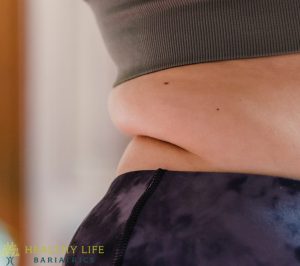
For life-changing results, after your weight loss surgery, you can consider skin removal surgery as well.
Using surgeries like the gastric sleeve and gastric bypass, patients can look forward to excess weight loss of up to 60% or more. If you are 100 pounds overweight, that amounts to a loss of sixty, seventy, or eighty pounds! The best part is that all the weight loss happens rapidly, usually within the first year following weight loss surgery. What’s unfortunate is that a small number of patients will be left with hanging skin afterward, resulting in the need for skin removal surgery.
What Causes Loose Skin After Weight Loss Surgery?
The skin of the human body is its largest organ. Skin is also highly adaptable. When a child sprouts a few inches, the skin expands the necessary amount to accommodate the new growth. The same goes with a bodybuilder who may gain ten pounds.
By gaining fat, the skin will expand to meet the new demands on the body. When that fat is lost, the skin will contract.
When you become obese after gaining weight steadily over the years, you may find that your skin has lost its ability to contract. This is referred to as your skin losing its elasticity, which can occur because of age, medications, illnesses, and heredity. Smoking can also cause loose skin to form after losing a tremendous amount of weight.
If you were to examine your skin under a microscope, you would see that the collagen and elastin, those compounds that give skin its ability to expand and retract, have become damaged. When you lose weight with damaged skin, you are left with saggy tissue. The skin simply hangs there and must be removed surgically.
Problems Caused by Hanging Skin After Weight Loss Surgery

Losing a hundred pounds or more means that you may be left with saggy skin in a number of places. Many people assume the excess tissue only exists on the abdomen. The extra skin can also appear on your arms, breasts, thighs, and buttocks. The abdomen just happens to be the area that proves the most troubling for many people. Not only is the saggy skin that remains after bariatrics a constant reminder of your former obese self, but there are other short and long-term problems, as well.
Mobility: When excess fat occurs on the abdomen, it tends to overhang, causing a fold or apron of skin. Medically, this saggy abdominal skin is referred to as a pannus (or panniculus). Having the extra skin can make it extra hard to move around.
Sitting: Having excess skin on your buttocks can make sitting awkward or even painful.
Rashes: Having a pannus can lead to painful rashes that never seem to heal and cause constant irritation, particularly in hot weather.
Lowered Body Image: Having all that excess skin can make wearing some clothing impossible. You aren’t able to celebrate your weight loss and may feel badly about your body. You may even hide away from social situations, the very behaviors you thought you would kick by choosing weight loss surgery.
A cosmetic body contouring surgeon can help with these problems by excising (cutting away) the excess fat and tissue. What we call skin removal surgery is actually a grouping of procedures performed by a body contouring surgeon. Let’s look at some of these procedures now.
Surgeries to Choose for Hanging Skin
Thanks to advancements in cosmetic surgery, and the abilities of these surgeries to produce natural-looking results, you now have more options than ever for eliminating excess skin from your body.
Abdominal Skin
If you have a panniculus and it’s causing you problems, a belt lipectomy can remove the tissue to give you a flatter tummy and slimmer abdomen. Your surgeon may instead opt for an abdominoplasty (tummy tuck) to repair separated abdominal muscles. Both procedures can give you a midsection that better represents your extreme weight loss.
In some cases, your cosmetic surgeon can employ a technique like Renuvion coupled with a tummy tuck to give you a flatter tummy and tighter skin. Renuvion uses J-Plasma technology to refresh and tighten tissue. J-Plasma employs a mixture of helium and sound energy to give your abdominal area a more youthful appearance without downtime, scarring, or discomfort after the skin has been removed.
Upper Arms
Losing a ton of weight can cause the upper arms to sag, giving a wing-like appearance. It’s no wonder why they’re often called “bat wings” or “bingo wings”. An arm lift (brachioplasty) can remove the excess skin from the underside of the arm for a slimmer, more toned appearance.
Breasts
Losing an extreme amount of weight can lead to the breasts losing fat and tissue, making them flat and droopy. A breast lift, also called a mastopexy, can remove the excess skin and reshape the breast. Your cosmetic surgeon can also raise your nipples and reposition your areolas for a more symmetrical effect. A breast lift will not alter the size of your breast. If you want larger breasts, a breast augmentation can help. Women wanting smaller breasts can benefit from a breast reduction.
Lower Back and Buttocks
Saggy skin on the lower back and buttocks can alter your body’s silhouette, making you appear larger than you are. A lower body lift or butt lift can give you the contours you crave. Your cosmetic surgeon will employ a hip-to-hip incision across the back and above the buttocks to excise the excess tissue, giving you a slimmer appearance.
Inner Thighs
Jiggly thighs and hanging skin on the upper leg area can be treated with a thigh lift. This procedure works by reducing the appearance of excess skin through an incision that begins high on the inner thigh, near the groin. The result is a pair of slimmer legs that highlight your amazing weight loss.
How Long After Weight Loss Should You Have Skin Removal Surgery?
The act of treating the body to cosmetic enhancements after weight loss surgery is called post-bariatric body contouring. Your bariatric surgeon will want to monitor your weight loss to ensure it stables out at some point. During the first year to two years, your body will continue losing weight following surgery. Only when your weight has stabilized will you be cleared for skin removal surgery. Generally speaking, body contouring surgeons want your weight to be stabilized for six months before giving the greenlight for a belt lipectomy.
Can Your Bariatric Surgeon Remove the Excess Skin?
Bariatric surgeons specialize in procedures aimed at helping you lose weight. The removal of skin after weight loss surgery is performed by a body contouring surgeon. If you live in Los Angeles and you experience saggy skin after losing a good amount of weight, you’re in luck. Dr. Babak Moeinolmolki is one of the rare surgeons who is dually-trained in both bariatrics and cosmetic body contouring!
Dr. Moeinolmolki can first help you drop the excess pounds cost-effectively with a procedure like the gastric sleeve. The doctor can then schedule you for the skin removal surgery of your choice after your weight has come off and stabilized. There is no need to change surgeons and you can have all of your procedures performed at the same surgical center, where your safety comes first.
To get started, call Healthy Life Bariatrics, where Dr. Moeinolmolki and his surgical staff look forward to treating you – (310)807-1735.


